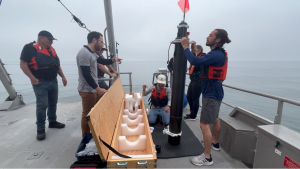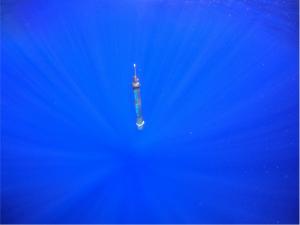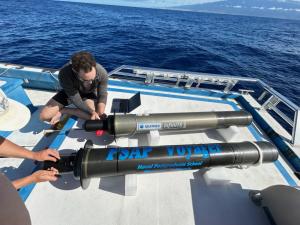NPS, Industry Research Leads to First in Persistent, Ocean Acoustic Data Collection Technology

Naval Postgraduate School, Seatrec team performs an early test of the Persistent Smart Acoustic Profiler (PSAP) Voyager off the NOAA R/V Fulmar in Monterey Bay.
The innovative project led to a milestone in the persistent monitoring of oceanographic and underwater acoustic data in real-time, and near indefinitely.
MONTEREY, CA, UNITED STATES, February 4, 2025 /EINPresswire.com/ -- A research partnership between the Naval Postgraduate School1 (NPS) and Seatrec has led to a milestone in the persistent monitoring of oceanographic and underwater acoustic data in real-time, and near indefinitely. The team’s successful development of an innovative, self-powered autonomous underwater drone, known as the Persistent Smart Acoustic Profiler (PSAP) Voyager, has already delivered large swaths of oceanographic and passive acoustic data primed for NPS student research since it was deployed for the first time off the coast of Kona, Hawaii, in early November of 2024.
Naval forces have an inherent operational reason to be quiet and stealthy at sea. Retired U.S. Navy Cmdr. John Joseph, a researcher in the NPS Department of Oceanography3 and principal investigator on the project, said the effort has been funded by the school’s Consortium for Unmanned Systems Education and Research2 (CRUSER), which is sponsored by the Office of Naval Research.
“PSAP started as a CRUSER project a few years ago when Yi Chao, Seatrec CEO and a well-known oceanographer, gave a talk at NPS about their energy-harvesting system,” said Joseph, who recognized an opportunity to combine the school’s expertise in undersea acoustics and research instrumentation with Seatrec’s innovative energy harvesting technology.
NPS excels at conducting applied research in the operating environment. For the first time, PSAP offers an ability to collect and send oceanographic and passive acoustic monitoring data in near real-time for an unlimited period, thanks to the profiler’s ability to harvest energy from the temperature differences in the ocean, enough to fully power the instrumentation indefinitely.
“Theoretically, PSAP can be deployed once, communicate its acoustic information to remote operators in near real time for limitless periods without requiring retrieval to offload data, refreshment - such as swapping batteries or data storage, or replacement,” explained Joseph. “These characteristics greatly reduce lifecycle costs of a continuous acoustic monitoring effort.”
Empowering student research and discovery is central to the institution’s efforts with industry partners, and the PSAP Voyager’s ongoing operational test – which can be monitored via the Seatrec website – has provided a trove of data for potential research.
“Now that we have a sizable amount of oceanographic and acoustic data collected by PSAP, we plan to have students in the undersea warfare and meteorology and oceanography curricula to use these data for thesis research,” said Joseph.
The role of acoustic sensing in Naval operations is far-reaching and fundamental to U.S. Navy and Marine Corps operations at sea, including undersea sensing and detection.
“Passive acoustic listening has many operational and research applications in the Navy, and our students at NPS conduct applied research to meet naval-unique needs for at-sea operations that require measurements of ambient noise, understanding the composition of soundscapes and monitoring of marine mammals,” said Joseph. The autonomy and endurance of the PSAP Voyager “provides an unprecedented opportunity to collect acoustic data in real-time for very long periods in remote areas without the expense and logistical tail of ship support.”
“Sound is used to ‘see’ underwater and is vital to understanding the ocean and monitoring the movement of natural and man-made objects,” added Yi Chao, Ph.D., Seatrec’s CEO and Founder in a recent news release. “Previously, hydrophones required power from expensive underwater cables from shore or ships but our PSAP Voyager untethers hydrophones and provides nearly unlimited persistent monitoring of the ocean in an extremely economical way.”
While the technology promises to be useful for improving maritime domain awareness, it will also enhance U.S. naval oceanographic models for operational planning used to improve own-force sonar system performance.
(This news story does not constitute an endorsement of Seatrec or its products and services by the Naval Postgraduate School, the Department of the Navy, or the Department of Defense.)
Lcdr. Kristina Wiedemann, USN
Naval Postgraduate School Public Affairs
831-656-3567
email us here
Visit us on social media:
Facebook
X
LinkedIn
Instagram
YouTube
1 https://nps.edu
2 https://nps.edu/web/cruser/welcome
3 https://nps.edu/web/oceanography


